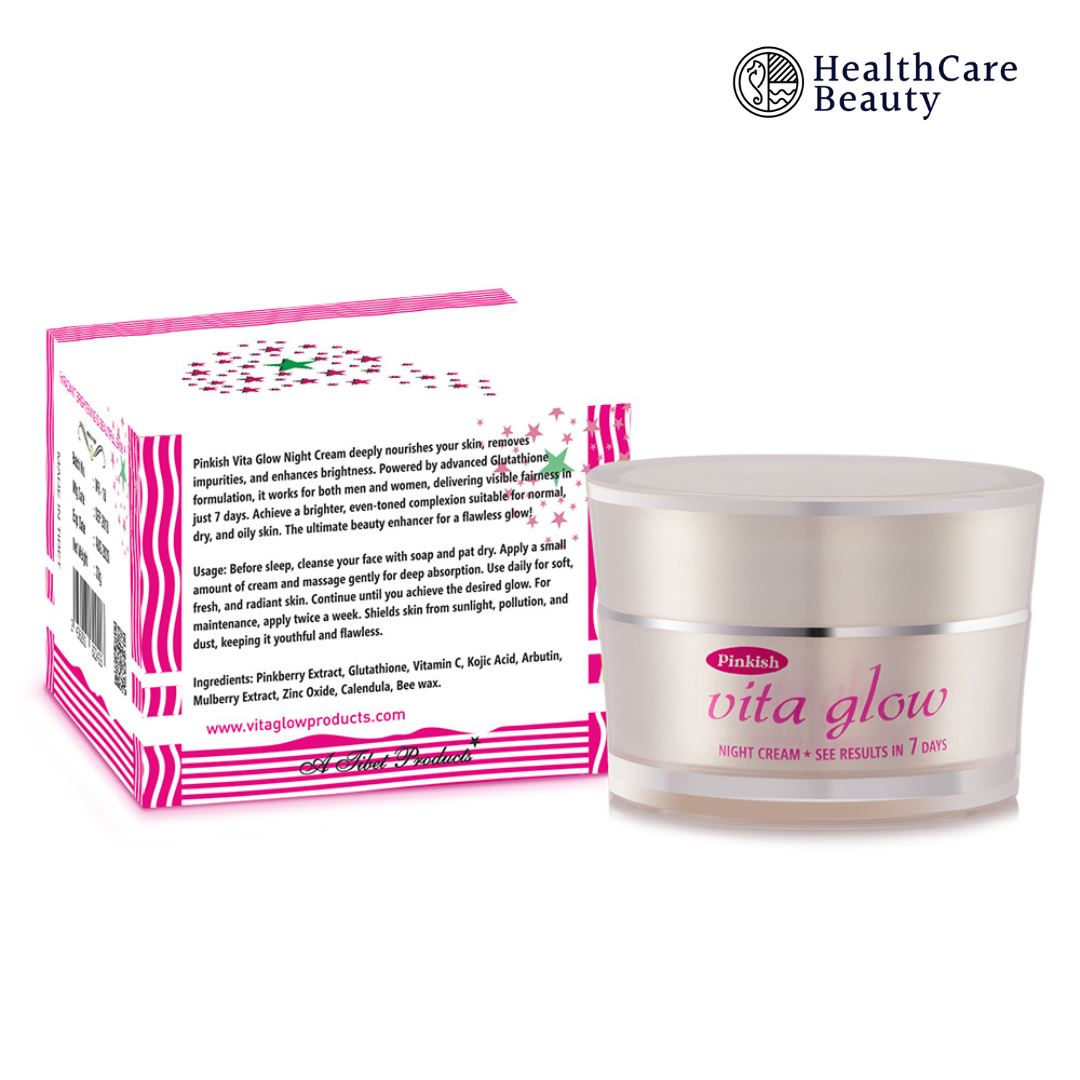Skin whitening creams like Pinkish Vita Glow Skin Whitening Night Cream have gained massive popularity, promising a brighter, fairer complexion. But with growing concerns about harmful ingredients in skin-lightening products, many wonder: Is Pinkish Vita Glow safe?
This in-depth guide examines the cream’s ingredients, potential risks, legal status, and safer alternatives to help you make an informed decision.

What is Pinkish Vita Glow Skin Whitening Night Cream?
Pinkish Vita Glow Night Cream is marketed as an overnight treatment that claims to:
✔ Lighten dark spots & hyperpigmentation
✔ Brighten dull skin
✔ Even out skin tone
✔ Provide a "pinkish glow" (hence the name)
But beyond the attractive promises, the real question is: What’s inside it, and is it safe for long-term use?
Key Ingredients in Pinkish Vita Glow: Are They Safe?
The safety of any skin-lightening product depends on its formulation. While the exact ingredients of Pinkish Vita Glow are not always fully disclosed, some versions may contain:
**1. Alpha Arbutin
- A natural skin-brightening agent derived from bearberry.
- Works by inhibiting tyrosinase, the enzyme responsible for melanin production.
- Generally safe, but high concentrations may cause mild irritation.
**2. Niacinamide (Vitamin B3)
- Reduces pigmentation and strengthens the skin barrier.
- Safe & recommended by dermatologists for most skin types.
**3. Kojic Acid
- A fungal-derived ingredient that lightens dark spots.
- Can cause irritation or redness in sensitive skin.
**4. Glycerin & Hyaluronic Acid
- Hydrating ingredients that improve skin texture.
- Safe and beneficial for all skin types.
⚠️ Potentially Harmful Ingredients (Found in Some Versions)
Several counterfeit or unregulated skin whitening creams have been found to contain:
- Hydroquinone (Banned in Many Countries)
- Can cause ochronosis (blue-black discoloration) with prolonged use.
- Mercury (Highly Toxic)
- Banned in cosmetics but still found in illegal products.
- Causes kidney damage, skin rashes, and neurological issues.
- Steroids (e.g., Clobetasol)
- Leads to skin thinning, redness, and dependency (skin worsens after stopping).
Since Pinkish Vita Glow Glutathione Cream is not strictly regulated, some batches may contain these dangerous additives.
Is Pinkish Vita Glow Skin Whitening Night Cream Safe?
✔ Possible Benefits (If Formulated Correctly)
- May help fade mild hyperpigmentation if it contains arbutin, niacinamide, or kojic acid.
- Hydrating ingredients can improve skin texture.
✖ Major Risks & Concerns
- Unregulated Market – Many fake versions contain illegal bleaching agents.
- No Long-Term Safety Data – Lack of clinical studies on its prolonged use.
- Rebound Pigmentation – Skin may darken if the product is discontinued.
- Skin Sensitivity & Allergies – Some users report redness, burning, or peeling.
🚨 Legal Status: Is Pinkish Vita Glow Banned?
- Some countries (like the UAE, Kenya, and parts of Europe) ban skin-lightening creams with hydroquinone or mercury.
- The FDA and EU strictly regulate whitening products, and unauthorized versions may be illegal.
- Always check if the product is approved by health authorities in your country.
How to Check If Your Pinkish Vita Glow is Safe
To avoid counterfeit or harmful products:
- Buy from Reputable Sellers – Official websites or authorized retailers.
- Check Ingredients List – Avoid creams listing hydroquinone, mercury, or steroids.
- Patch Test First – Apply a small amount on your wrist to check for reactions.
- Look for Certification – FDA, EU Cosmetics Regulation, or dermatologist-approved labels.
Safer Alternatives to Pinkish Vita Glow
If you’re concerned about risks, consider these dermatologist-recommended alternatives:
1. Vitamin C Serums
- Brightens skin and fights free radicals.
2. Azelaic Acid (10-20%)
- Reduces pigmentation without harsh side effects.
3. Licorice Root Extract
- Natural skin brightener with anti-inflammatory benefits.
4. Retinoids (Retinol or Tretinoin)
- Fades dark spots by increasing cell turnover.
5. Professional Treatments (For Stubborn Pigmentation)
- Chemical Peels, Laser Therapy, or Microdermabrasion – More effective and controlled than creams.
Final Verdict: Should You Use Pinkish Vita Glow?
- If the product is authentic and free from banned ingredients, it may help with mild pigmentation.
- For melasma or deep dark spots, consult a dermatologist for safer treatments.
- Avoid if you experience irritation—discontinue use immediately.
Bottom Line:
While Pinkish Vita Glow Skin Whitening Night Cream may offer temporary brightening, the risks of unregulated formulations outweigh the benefits. For long-term skin health, opt for clinically proven, safe alternatives.
Have you tried Pinkish Vita Glow? Share your experience in the comments!
Comments
Post a Comment